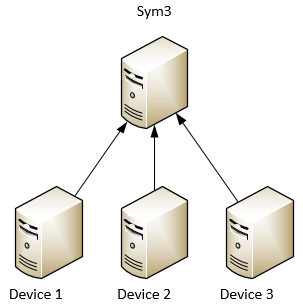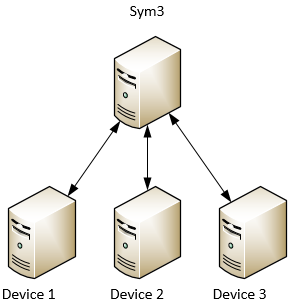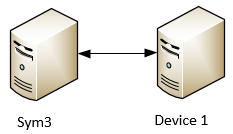
Communicating with a device via the UDP message driver uses the UDP/IP protocol and Windows sockets. The integrator end point may be set as a server (listening socket) or a client (connecting socket).
The recognised configuration properties are listed below:
| Name | Type | Default Value | Description |
| Server | Boolean | False | Flag to indicate whether this is a server or client |
| IPAddress | IP address/Host name | Unique ID that must match the DeviceID of the message headers going or coming from to this PLC | |
| ClientPort | Port Number | 15000 | Indicates the port number to connect to. Optional in Server mode. See examples |
| ListenPort | Port Number | 16000 | Indicates the port number Sym3 listens on. Optional in client mode. See examples |
| MsgID | Message ID | 0 | Sym3 message number used for Server mode without the Sym3 Header (StripHeader=true) |
| StripHeader | Boolean | False | When messages are sent and received the Sym3 Header is not sent as part of the message on the network. This allows devices that do not use the Sym3 Header to communicate with Sym3 |
| ReconnectTime | Unsigned Integer | 5000 ms | Time between client reconnection attempts (seconds). Valid for client only |
| NetworkByteOrder | Boolean | False | Identifies the endian order of the message header numeric values. The device IO contents are treated as single bytes therefore not swapped. |
| Autoconnect | Boolean | True | (optional true if not specified). If false, Sym3 won't connect to this device until an explicit call to ConnectDevice() is made from the script. |
| BufferSize | Number | 1024 | Optional. Number of bytes for the buffer used for communication. Default 1024 bytes |
| ContinuouslySendingOutput | Boolean | False | Optional. Output messages are sent only if an output data has been changed. If you want Sym3 to continuously send messages you can set the flag to 'True'. Warning: this may affect performance significantly. Sym3 does not recommend using this setting. The update rate used will be the UpdateRate set for output data. The only way to change this is to export DeviceIOs to CSV file and change the last column then re-import the CSV file. Default rate is set to 50ms. |
Examples
Server examples
1 - Sym3 listening on specific port with one or more devices sending Datagrams. Sym3 receives UDP Datagram and assigns message number 100 for Sym3 Device IO / Scripts to process. Sym3 Headers are not sent on the network.

Configuration:
server = true listenport = 16000 stripheader = true msgid = 100
2 - Sym3 listening on specific port with one or more devices sending Datagrams. Sym3 sends messages to each of the clients. Messages may be sent to specific client or to all clients by sending using the Sym3 Server Device (MyServer).
The clients must have the ListenPort set to the MyServer listen port. Client ports may be different from each other.

Configuration:
MyServer:server = true listenport = 16000
Device1:
server = false ipaddress = 192.168.1.1 clientport = 17000 listenport = 16000
Device2:
server = false ipaddress = 192.168.1.2 clientport = 17001 listenport = 16000
Device3:
server = false ipaddress = 192.168.1.3 clientport = 17000 listenport = 16000
3 - Sym3 listening on specific port and sending Datagrams to a device / server listening on specific port.

Configuration:
server = true ipaddress = 192.168.1.1 listenport = 16000 clientport = 16000
Client example
Sym3 connecting to device on specific port and using random assigned port from host operating system. Device replies to peer (Sym3) port.

Configuration:
server = false ipaddress = 192.168.1.1 clientport = 16000 reconnecttime = 10 networkbyteorder = false
NOTE: Configuration data is not case sensitive and white space is ignored.